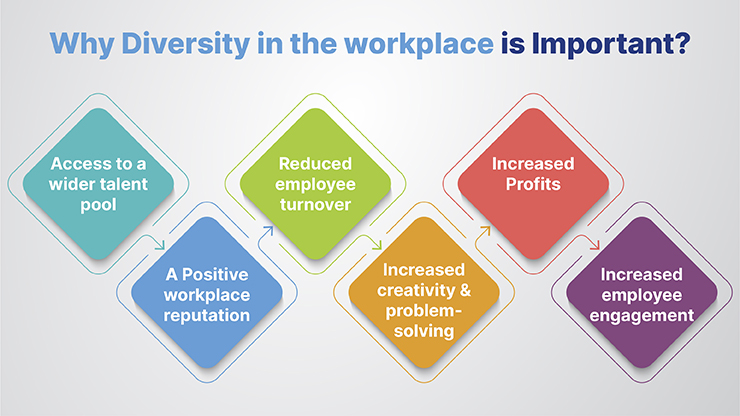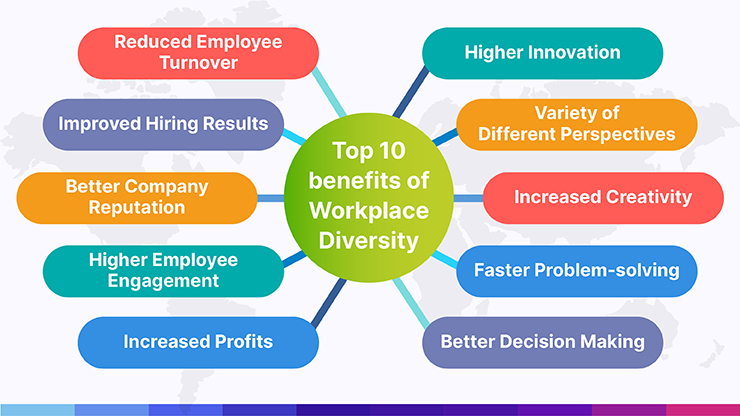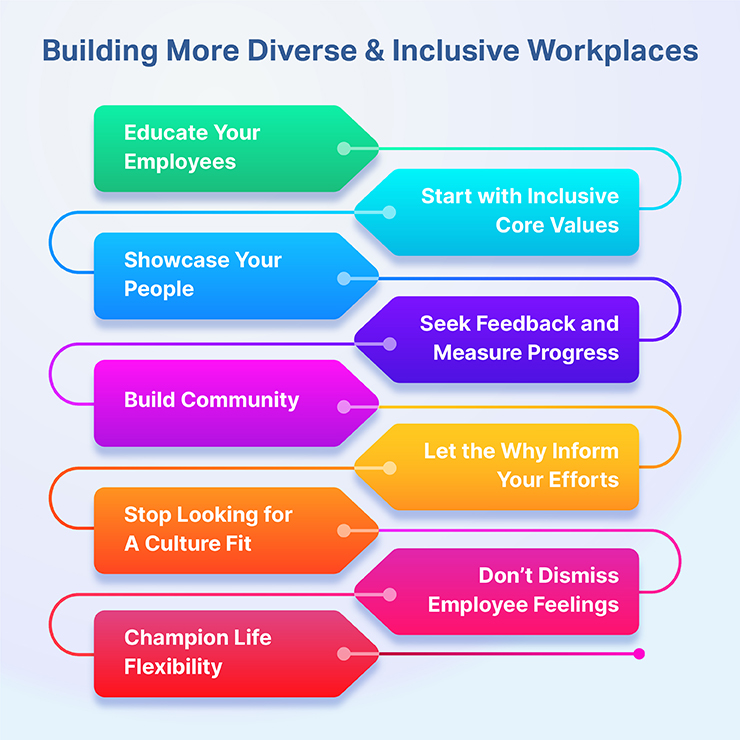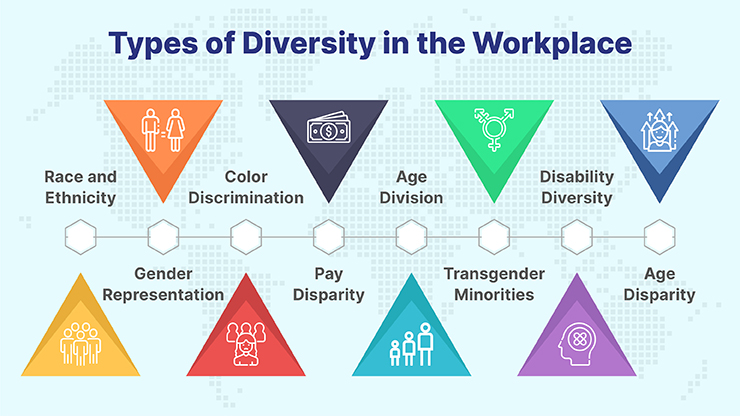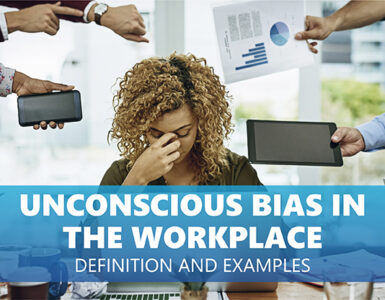What Is Diversity in the Workplace?
Diversity in the workplace refers to the intentional inclusion and representation of individuals from a wide range of backgrounds, experiences, and characteristics. It encompasses differences in race, gender, age, ethnicity, religion, sexual orientation, socioeconomic status, physical abilities, and other attributes. A diverse workplace not only acknowledges these differences but also values and leverages them to foster a more inclusive, innovative, and harmonious environment. Such diversity is crucial in reflecting the complexity of the global market and ensuring a broader spectrum of perspectives, leading to better decision-making and enhanced productivity. In essence, workplace diversity champions the principle that every individual, irrespective of their background, has unique experiences and insights that can contribute to the overall success and growth of an organization.
#10 Examples of diversity in the workplace
Here are some examples of diversity in the workplace, along with explanations:
Ethnic and Racial Diversity:
This means employing people from different races, nationalities, and ethnicities. By doing so, a company can benefit from the diverse perspectives, insights, and experiences that come from different cultures.
Gender and Gender Identity Diversity:
It’s essential to have a balance of male, female, and non-binary individuals, as well as people of varying gender identities and expressions. This ensures a range of experiences and viewpoints that can be especially valuable in team dynamics and problem-solving.
Age Diversity:
This involves employing people from different age groups – from younger individuals to older workers. Different age groups bring varied experiences, approaches, and knowledge that can benefit the company.
Socioeconomic Diversity:
Hiring individuals from various socioeconomic backgrounds ensures that the company benefits from the insights and experiences of people who’ve had different life challenges and opportunities.
Educational Diversity:
Employees might have degrees from different countries, fields of study, or educational levels. A diverse educational background can lead to innovative solutions and fresh perspectives on issues.
Sexual Orientation Diversity:
Including LGBTQ+ employees ensures representation and a broader range of life experiences and perspectives. This form of diversity also creates an inclusive environment where everyone can feel safe and accepted.
Religious Diversity:
People from various religions and belief systems can offer unique perspectives and values. Respecting and acknowledging different religious observances and holidays can also foster a more inclusive workplace environment.
Disability Diversity:
Hiring individuals with disabilities, both visible and invisible, is crucial. They can offer unique perspectives and problem-solving skills, and their inclusion also promotes a culture of accessibility and inclusivity.
Cognitive and Neurodiversity:
Embracing individuals with varied cognitive abilities or conditions such as ADHD, autism, or dyslexia means acknowledging that everyone thinks and processes information differently. This diversity can lead to innovative ways of tackling challenges.
Cultural Diversity:
With the globalization of businesses, having a mix of individuals from various cultures ensures that the company is more globally minded-and can cater to a broader range of clients and customers.
Why is diversity so important?
Here’s why diversity holds such significance:
Enhanced Creativity and Innovation:
Diverse teams bring together varied perspectives, experiences, and approaches. This mix can lead to increased creativity and the generation of novel solutions to complex problems.
Improved Decision Making:
Research has shown that diverse teams make better decisions. This is because they consider a broader range of perspectives, which can result in more comprehensive analyses of situations.
Reflects the Global Market:
In our interconnected world, businesses often cater to global audiences. A diverse workforce can offer insights into different market segments, ensuring products and services appeal to a wide range of consumers.
Attracts and Retains Talent:
An inclusive and diverse environment can be a major draw for potential employees. Such workplaces are often seen as more progressive, adaptive, and aligned with contemporary values.
Economic Growth:
Diversity can lead to increased profitability and ROI. Companies with more diverse management teams report higher innovation revenues.
Social Cohesion:
Embracing diversity fosters mutual respect among different groups, leading to a more harmonious, integrated, and cohesive society.
Challenge Status Quo:
Diversity can challenge entrenched ways of thinking, preventing groupthink and promoting critical assessment of established practices.
Improved Customer Service:
A diverse team can better understand and cater to the needs of a diverse customer base. Employees from different backgrounds may have insights into specific cultural nuances or preferences.
Boosts Employee Performance:
Employees in diverse and inclusive environments often report better job satisfaction and engagement. This can lead to improved performance and reduced turnover.
Promotes Personal Growth:
Interacting with people from different backgrounds can challenge and expand our viewpoints, enriching our personal and professional lives.
Ethical and Moral Imperative:
Beyond the practical benefits, promoting diversity is the right thing to do. Everyone, regardless of their background, deserves equal opportunities and a chance to contribute to society.
Compliance and Representation:
Many countries have laws and regulations promoting or mandating certain aspects of diversity. Complying with these not only avoids legal repercussions but also ensures representation.
Cultural Exchange:
Diversity promotes cultural exchange, leading to a richer, more varied society where individuals learn from one another’s experiences and histories.
Resilience:
Diverse teams can adapt more quickly to changes. With a wide range of viewpoints, they are less likely to be blindsided by challenges.
#12 Benefits of Diversity in the Workplace
Diversity in the workplace brings a multitude of benefits, both tangible and intangible. Here are some of the primary advantages:
Enhanced Creativity and Innovation: Diverse teams tend to offer a variety of perspectives, experiences, and approaches, often leading to greater creativity and the birth of innovative solutions.
Better Decision Making: Research has shown that diverse groups often make better, faster decisions. They consider a broader range of perspectives, resulting in more comprehensive and well-rounded decisions.
Improved Financial Performance: Several studies indicate that companies with diverse teams tend to have better financial returns, likely due to improved decision-making and innovation.
Reflecting the Global Market: A diverse workforce can mirror the global marketplace, offering insights into different demographic segments and ensuring products and services appeal to a diverse clientele.
Attracting and Retaining Talent: An inclusive workplace can be a major draw for potential employees. Companies that prioritize diversity are often seen as more forward-thinking and adaptive.
Enhanced Employee Performance: Employees tend to perform better in an inclusive environment where they feel their contributions are valued and their well-being is prioritized.
Reduced Employee Turnover: Companies that promote diversity and inclusion are more likely to retain their employees, reducing costs related to employee turnover.
Broader Skill Set: A diverse workforce brings varied skills, knowledge, and experiences, which can be advantageous in addressing a wide array of challenges.
Improved Customer Service: Diverse teams can understand and cater to the needs of a broader customer base. Employees from various backgrounds might offer insights into cultural nuances or preferences.
Better Company Reputation: Organizations that prioritize diversity are often seen as ethical and socially responsible, which can enhance their reputation in the market.Risk Management: Diverse teams can provide a broader viewpoint, helping companies foresee potential risks from various angles, thus aiding in risk mitigation.
Enhanced Flexibility: Companies that are diverse tend to be more flexible in adapting to external changes, as they have a more extensive range of experiences to draw from.
#15 Ways to Promote Diversity in the Workplace
list of ways to promote diversity in the workplace:
Leadership Endorsement: Ensure top management actively supports and champions diversity initiatives.
Inclusive Hiring: Implement unbiased recruitment practices and expand outreach to diverse candidate pools.
Neutral Job Ads: Use inclusive language and imagery in recruitment materials.
Training Sessions: Offer programs that address unconscious biases and enhance cultural awareness.
Mentorship Programs: Pair underrepresented employees with experienced colleagues for guidance.
Employee Resource Groups: Support groups that focus on specific demographics, offering networking and support.
Feedback Mechanisms: Conduct surveys to understand diverse employee experiences and concerns.
Cultural Celebrations: Acknowledge and celebrate various cultural and religious events.
Transparent Reviews: Ensure performance evaluations are standardized, clear, and free from biases.
Diverse Leadership: Strive for diversity at all company levels, especially in leadership positions.
Review Policies: Continually assess workplace policies for inclusivity and fairness.
Flexible Work Options: Offer arrangements like remote work or flexible hours to cater to diverse needs.
Equal Opportunities: Ensure all staff have the same access to training, development, and promotions.
Safe Reporting: Provide channels for employees to anonymously report diversity-related concerns.
Collaborate Externally: Partner with organizations that specialize in diversity and inclusion for expertise.
#15 Challenges of Achieving Diversity in the Workplace
Here are some of the most commonly faced obstacles:
Unconscious Bias: Even with the best intentions, individuals might hold unconscious prejudices that influence their decisions, especially in hiring or promotions.
Resistance to Change: Employees accustomed to a homogenous workplace might resist diversification efforts, fearing change or feeling threatened.
Cultural Misunderstandings: As diversity increases, so does the potential for misunderstandings due to cultural, linguistic, or social differences.
Integration Difficulties: Introducing diverse employees into a previously homogenous team can lead to initial integration challenges.
Overemphasis on Representation: There’s a risk of focusing solely on numbers (e.g., hiring quotas) rather than creating a genuinely inclusive environment.
Tokenism: This refers to the practice of hiring a person from an underrepresented group merely to appear diverse, without giving them real opportunities or inclusion.
Lack of Top-Down Commitment: Without genuine commitment from leadership, diversity initiatives may lack the necessary resources or emphasis.
Legal and Regulatory Concerns: Efforts to promote diversity need to align with employment laws, which can vary greatly between countries.
Cost Implications: Implementing diversity and inclusion programs, training sessions, and other related initiatives can entail significant costs.
Limited Access to Diverse Talent Pools: In certain industries or regions, there might be limited access to a diverse pool of qualified candidates.
Language Barriers: In multinational companies, language differences can pose communication challenges.
Overlooking Intersectionality: Diversity is multifaceted. A person can belong to several underrepresented groups, and initiatives must consider this overlap.
Measuring Diversity: Quantifying and assessing the true extent and impact of diversity in an organization can be complex.
False Perceptions: Some might wrongly perceive that an emphasis on diversity means compromising on qualifications or merit.
Retention Concerns: Even if a company successfully hires a diverse workforce, retaining those employees by ensuring they feel valued and included is another challenge.
#16 Types of Diversity in the Workplace
Here are some of the main types of diversity commonly recognized in organizational settings:
Ethnic and Racial Diversity: Recognizing and including individuals from various racial, ethnic, and national backgrounds.
Gender and Gender Identity Diversity: Involves the representation and inclusion of various genders, including male, female, non-binary, and transgender individuals.
Age Diversity: Embracing employees from different age groups, from younger generations to older professionals, each bringing unique perspectives based on their life experiences.
Socioeconomic Diversity: Including individuals from different economic and social backgrounds, each offering unique perspectives shaped by their socio-economic experiences.
Cultural Diversity: Recognizing and valuing differences in customs, traditions, beliefs, and values due to cultural backgrounds.
Religious Diversity: Respecting and accommodating employees from various religious and spiritual backgrounds.
Sexual Orientation Diversity: Acknowledging and including individuals across the spectrum of sexual orientations, such as heterosexual, homosexual, bisexual, asexual, etc.
Disability Diversity: Integrating individuals with physical, cognitive, and psychological disabilities, ensuring equal opportunities and inclusivity.
Cognitive and Neurodiversity: Recognizing that people think and process information differently, which includes conditions like ADHD, autism, dyslexia, etc.
Educational Diversity: Valuing various educational backgrounds, whether formal degrees, vocational training, self-taught skills, or other forms of education.
Functional or Departmental Diversity: Including professionals from various departments or functions like HR, finance, engineering, sales, etc., fostering cross-functional collaboration.
Industry Experience Diversity: Employees might come from different industry backgrounds, bringing varied experiences and best practices.
Language Diversity: Inclusion of multilingual individuals or those whose primary language may not be the dominant one in the workplace.
Skillset Diversity: Recognizing that individuals have varied skill sets, both soft and hard, that they bring to the team.
Work Experience and Background Diversity: Employees might come from different professional backgrounds, career paths, or work histories.
Veteran Status: Recognizing and valuing the experiences and skills of military veterans.


